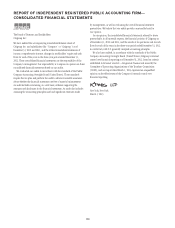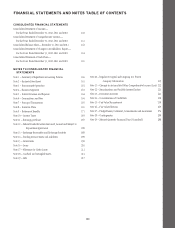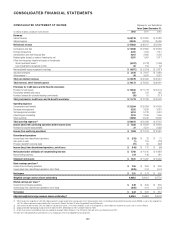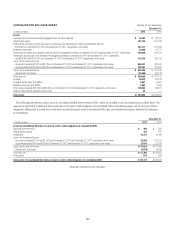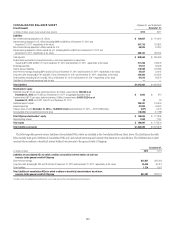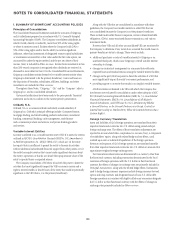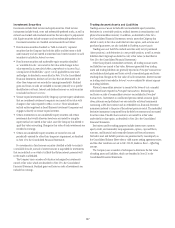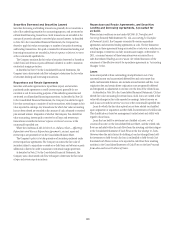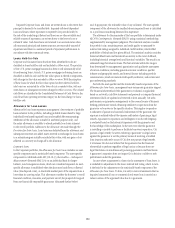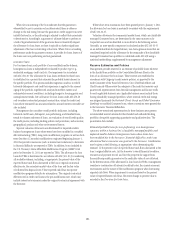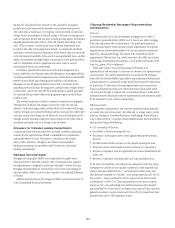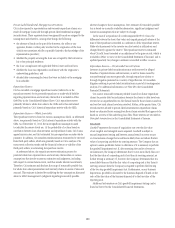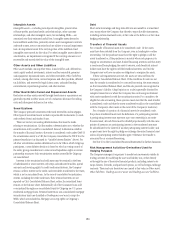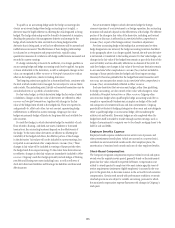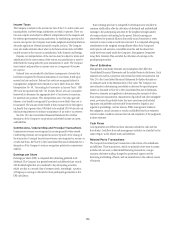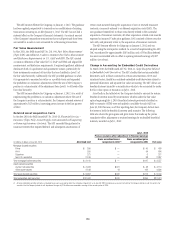Citibank 2012 Annual Report Download - page 170
Download and view the complete annual report
Please find page 170 of the 2012 Citibank annual report below. You can navigate through the pages in the report by either clicking on the pages listed below, or by using the keyword search tool below to find specific information within the annual report.148
Securities Borrowed and Securities Loaned
Securities borrowing and lending transactions generally do not constitute a
sale of the underlying securities for accounting purposes, and are treated as
collateralized financing transactions. Such transactions are recorded at the
amount of proceeds advanced or received plus accrued interest. As described
in Note 26 to the Consolidated Financial Statements, the Company has
elected to apply fair value accounting to a number of securities borrowing
and lending transactions. Fees paid or received for all securities lending and
borrowing transactions are recorded in Interest expense or Interest revenue
at the contractually specified rate.
The Company monitors the fair value of securities borrowed or loaned on
a daily basis and obtains or posts additional collateral in order to maintain
contractual margin protection.
As described in Note 25 to the Consolidated Financial Statements, the
Company uses a discounted cash flow technique to determine the fair value
of securities lending and borrowing transactions.
Repurchase and Resale Agreements
Securities sold under agreements to repurchase (repos) and securities
purchased under agreements to resell (reverse repos) generally do not
constitute a sale for accounting purposes of the underlying securities and
are treated as collateralized financing transactions. As described in Note 26
to the Consolidated Financial Statements, the Company has elected to apply
fair value accounting to a majority of such transactions, with changes in fair
value reported in earnings. Any transactions for which fair value accounting
has not been elected are recorded at the amount of cash advanced or received
plus accrued interest. Irrespective of whether the Company has elected fair
value accounting, interest paid or received on all repo and reverse repo
transactions is recorded in Interest expense or Interest revenue at the
contractually specified rate.
Where the conditions of ASC 210-20-45-11, Balance Sheet—Offsetting:
Repurchase and Reverse Repurchase Agreements, are met, repos and
reverse repos are presented net on the Consolidated Balance Sheet.
The Company’s policy is to take possession of securities purchased under
reverse repurchase agreements. The Company monitors the fair value of
securities subject to repurchase or resale on a daily basis and obtains or posts
additional collateral in order to maintain contractual margin protection.
As described in Note 25 to the Consolidated Financial Statements, the
Company uses a discounted cash flow technique to determine the fair value
of repo and reverse repo transactions.
Repurchase and Resale Agreements, and Securities
Lending and Borrowing Agreements, Accounted for
as Sales
Where certain conditions are met under ASC 860-10, Transfers and
Servicing (formerly FASB Statement No. 166, Accounting for Transfers
of Financial Assets), the Company accounted for certain repurchase
agreements and securities lending agreements as sales. The key distinction
resulting in these agreements being accounted for as sales was a reduction in
initial margin or restriction in daily maintenance margin. At December 31,
2011, a nominal amount of these transactions were accounted for as
sales that reduced Trading account assets. See related discussion of the
assessment of the effective control for repurchase agreements in “Accounting
Changes” below.
Loans
Loans are reported at their outstanding principal balances net of any
unearned income and unamortized deferred fees and costs except that
credit card receivable balances also include accrued interest and fees. Loan
origination fees and certain direct origination costs are generally deferred
and recognized as adjustments to income over the lives of the related loans.
As described in Note 26 to the Consolidated Financial Statements, Citi has
elected fair value accounting for certain loans. Such loans are carried at fair
value with changes in fair value reported in earnings. Interest income on
such loans is recorded in Interest revenue at the contractually specified rate.
Loans for which the fair value option has not been elected are classified
upon origination or acquisition as either held-for-investment or held-for-sale.
This classification is based on management’s initial intent and ability with
regard to those loans.
Loans that are held-for-investment are classified as Loans, net of
unearned income on the Consolidated Balance Sheet, and the related cash
flows are included within the cash flows from the investing activities category
in the Consolidated Statement of Cash Flows on the line Change in loans.
However, when the initial intent for holding a loan has changed from held-
for-investment to held-for-sale, the loan is reclassified to held-for-sale, but
the related cash flows continue to be reported in cash flows from investing
activities in the Consolidated Statement of Cash Flows on the line Proceeds
from sales and securitizations of loans.


